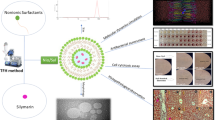Summary
The purpose of this study was to develop docetaxel-poly (lactide-co-glycolide) (PLGA) loaded nanoparticles by using nanoprecipitation method and optimize the relative parameters to obtain nanoparticles with higher encapsulation efficiency and smaller size. The physicochemical characteristics of nanoparticles were studied. The optimized parameters were as follows: the oil phase was mixture of acetone and ethanol, concentration of tocopheryl polyethylene glycol succinate (TPGS) was 0.2%, the ratio of oil phase to water phase was 1:5, and the theoretical drug concentration was 5%. The optimized nanoparticles were spherical with size between 130 and 150 nm. The encapsulation efficiency was (40.83±2.1)%. The in vitro release exhibited biphasic pattern. The results indicate that docetaxel-PLGA nanoparticles were successfully fabricated and may be used as the novel vehicles for docetaxel, which would replace Taxotere® and play great roles in future.
Similar content being viewed by others
References
Petrioli R, Pozzessere D, Messinese S, et al. Weekly low-dose docetaxel in advanced non-small cell lung cancer previously treated with two chemotherapy regimens. Lung Cancer, 2003,39(1):85–89
Coleman RE, Howell A, Eggleton SP, et al. Phase II study of docetaxel in patients with liver metastases from breast cancer. Ann Oncol, 2000,11(5):541–546
Glisson BS, Murphy BA, Frenette G, et al. Phase II trial of docetaxel and cisplatin combination chemotherapy in patients with squamous cell carcinoma of the head and neck. J Clin Oncol, 2002,20(6):1593–1599
Rowinsky EK. The development and clinical utility of the taxane class of antimicrotubule chemotherapy agents. Annu Rev Med, 1997,48:353–374
Weiss RB, Donehower RC, Wiernik PH, et al. Hypersensitivity reactions from Taxol. J Clin Oncol, 1990,8(7):1263–1268
Chu CY, Yang CH, Yang CY, et al. Fixed erythrodysaesthesia plaque due to intravenous injection of docetaxel. Br J Dermatol, 2000,142(4):808–811
Lavelle F, Bissery MC, Combeau C, et al. Preclinical evaluation of docetaxel (Taxotere). Semin Oncol, 1995,22(2 Suppl 4):3–16
Xu Z, Chen L, Gu W, et al. The performance of docetaxel-loaded solid lipid nanoparticles targeted to hepatocellular carcinoma. Biomaterials, 2009,30(2):226–232
Farokhzad OC, Langer R. Impact of nanotechnology on drug delivery. ACS Nano, 2009,3(1):16–20
Haley B, Frenkel E. Nanoparticles for drug delivery in cancer treatment. Urol Oncol, 2008,26(1):57–64
Saha RN, Vasanthakumar S, Bende G, et al. Nanoparticulate drug delivery systems for cancer chemotherapy. Mol Membr Biol, 2010,27(7):215–231
Bennis S, Chapey C, Couvreur P, et al. Enhanced cytotoxicity of doxorubicin encapsulated in polyisohexylcy-anoacrylate nanospheres against multidrug-resistant cells in culture. Eur J Cancer, 1994,30A(1):89–93
Magenheim B, Benita S. Nanoparticle characterization: a comprehensive physicochemical approach. STP Pharm Sci, 1991,1:221–241
Shive MS, Anderson JM. Biodegradation and biocompatibility of PLA and PLGA microspheres. Adv Drug Deliv Rev, 1997,28(1):5–24
Gan CW, Feng SS. Transferrin-conjugated nanoparticles of poly (lactide)-D-alpha-tocopheryl polyethylene glycol succinate diblock copolymer for targeted drug delivery across the blood-brain barrier. Biomaterials, 2010,31(30):7748–7757
Zhang Z, Mei L, Feng SS. Vitamin E D-alpha-tocopheryl polyethylene glycol 1000 succinate-based nanomedicine. Nanomedicine (Lond), 2012,7(11):1645–1647
Saxena V, Hussain MD. Inhibition of P-glycoprotein by D-alpha-tocopheryl polyethylene glycol 1000 succinate (TPGS). J Biomed Nanotechnol, 2013,9(7):1146–1154
Varma MV, Panchagnula R. Enhanced oral paclitaxel absorption with vitamin E-TPGS: effect on solubility and permeability in vitro, in situ and in vivo. Eur J Pharm Sci, 2005,25(4–5):445–453
Collnot EM, Baldes C, Schaefer UF. Vitamin E TPGS p-glycoprotein inhibition mechanism: influence on conformational flexibility, intracellular ATP levels, and role of time and site of access. Mol Pharm, 2010,7(3):642–651
Zhang Z, Lee SH, Gan CW, et al. In vitro and in vivo investigation on PLA-TPGS nanoparticles for controlled and sustained small molecule chemotherapy. Pharm Res, 2008,25(8):1925–1935
Prashant C, Dipak M, Yang CT, et al. Superparamagnetic iron oxide-loaded poly (lactic acid)-D-alpha-tocopherol polyethylene glycol 1000 succinate copolymer nanoparticles as MRI contrast agent. Biomaterials, 2010,31(21):5588–5597
Win KY, Feng SS. In vitro and in vivo studies on vitamin E TPGS-emulsified poly(D,L-lacticcoglycolid acid) nanoparticles for paclitaxel formulation. Biomaterials, 2006, 27(10):2285–2291
Barichello JM, Morishita M, Takayama K, et al. Encapsulation of hydrophilic and lipophilic drugs in PLGA nanoparticles by the nanoprecipitation method. Drug Dev Ind Pharm, 1999,25(4):471–476
Dong Y, Feng SS. Methoxyl poly(ethylene glycol)poly-(lactide) (MPEG-PLA) nanoparticles for controlled delivery of anticancer drugs. Biomaterials, 2004,25(14):2843–2849
Zhang Z, Feng SS. Nanoparticles of poly (lactide)/Vitamin E TPGS copolymer for cancer chemotherapy: synthesis, formulation, characterization and in vitro drug release. Biomaterials, 2006,27(2):262–270
Mu L, Feng SS. A novel controlled release formulation for the anticancer drug paclitaxel (Taxol): PLGA nanoparticles containing vitamin E TPGS. J Control Release, 2003,86(1):33–48
Mu L, Feng SS. Vitamin E TPGS used as emulsifier in the solvent evaporation/extraction technique for fabrication of polymeric nanospheres for controlled release of paclitaxel (Taxol). J Control Release, 2002,80(1–3):129–144
Kakran M, Sahoo NG, Antipina MN, et al. Modified supercritical antisolvent method with enhanced mass transfer to fabricate drug nanoparticles. Mater Sci Eng C Mater Biol Appl, 2013,33(5):2864–2870
Song X, Zhao Y, Hou S, et al. Dual agents loaded PLGA nanoparticles: Systematic study of particle size and drug entrapment efficiency. Eur J Pharm Biopharm, 2008,69(2):445–453
Lamprecht A, Ubrich N, Hombreiro Pérez M, et al. Influences of process parameters on nanoparticle preparation performed by a double emission pressure homogenization technique. Int J Pharm, 2000,196(2):177–182
Zhao L, Feng SS. Enhanced oral bioavailability of paclitaxel formulated in vitamin E-TPGS emulsified nanopart icles of biodegradable polymers: in vitro and in vivo studies. J Pharm Sci, 2010, 99(8):3552–3560
Zhang Z, Feng SS. Nanoparticles of poly (lacide)/vitamin E TPGS copolymer for cancer chemotherapy: synthesis, formulation, characterization and in vitro drug release. Biomaterials, 2006,27(2):262–270
Author information
Authors and Affiliations
Corresponding author
Additional information
The authors contributed equally to this work.
This project was supported by National Natural Science Foundation of China (No. H1610 81172121).
Rights and permissions
About this article
Cite this article
Shi, W., Zhang, Zj., Yuan, Y. et al. Optimization of parameters for preparation of docetaxel-loaded PLGA nanoparticles by nanoprecipitation method. J. Huazhong Univ. Sci. Technol. [Med. Sci.] 33, 754–758 (2013). https://doi.org/10.1007/s11596-013-1192-x
Received:
Revised:
Published:
Issue Date:
DOI: https://doi.org/10.1007/s11596-013-1192-x




